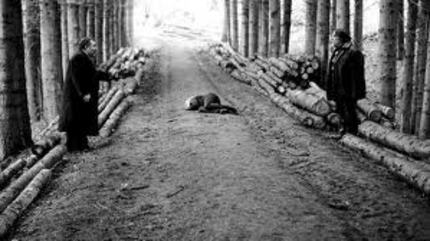Sitges 2011: KILL ME PLEASE Review

Euthanasia is an increasingly relevant topic today, with more and more people advocating for assisted suicide for the terminally ill. So it is perhaps inevitable that a film would come along that explores a clinic that provides such as service. It is interesting to find a film that deals with the subject matter both with great care and frequent extreme dark comed. Such is Olias Barco's second feature film, Kill Me Please.
Somewhere in the Belgian countryside, Dr. Kruger operates a clinic whose main purpose is to disuade the most depressed from their goal of ending their life. However, in the event that Kruger is unsuccessful, he is willing to provide them with a cyanide cocktail. His patients range from those with terminal or debilitating illnesses, to the hopeless, to the most definitely crazy. His staff are few but loyal, and he receives outright hatred from the local townspeople. Still, Kruger perservers, and sometimes he is successful. Not everything is going to plan, though: he cannot seem to fulfill some of his patient's last wishes, and they are beginning to rebel. And it seems the townspeople have decided to take matters into their own hands in regards to the elimination of Kruger and his practice.
Barco and fellow screenwriters Stephane Malandrin and Virgile Bramly walk a very thin line between drama and comedy quite successfully. There are moments of extreme delicacy and sadness, as the witnessing of one patient's last wish and death. But these are matched by those of extreme comedy, such as when two of the patients argue over their respective reasons for wanting suicide. (Apparently, the loss of a wife in a poker game is not sufficient.) It seems very wrong to laugh over such a serious subject, but Barco makes the characters and situations just absurd enough to allow it. The film is shot in black and white, as if to emphasize the non-black and white situation of suicide. At times, it has a documentary quality, as if trying to instill a sense of immediacy for the audience. At other times, it feels almost like a Blake Edwards farce. Set in winter, when death seems somewhat more possible and haunting, the patients seem far more alive than one would expect. Perhaps that is where humour enters in: to discuss something this serious, it must have a slightly light touch. And humour about such a subject could only be dark.
A strong cast (including Benoit Poelvoorse and Saul Rubinek) allow the audience to be both entertained and horrified. The castle-like setting of the film borders on Frankenstein territory, with Kruger as the mad doctor and the townspeople substituting guns for pitchforks. The film keeps itself light enough to accept as fiction, but dark enough to understand as fairly realistic metaphor.







